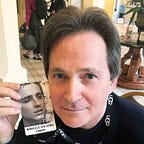Common Log Line Mistakes
Here are few common mistakes to avoid when crafting a stand-alone log line. A stand-alone log line is one that must “stand alone” as the sole pitch, with no other context forthcoming. For a deeper dive into log lines and pitching, check out the book I co-wrote with Doug Eboch, The Hollywood Pitching Bible.
Before we start, I will assume you have a viable story to begin with. I don’t mean commercially viable, although that would probably help. Instead, I’m assuming you already have a narratively viable idea: Is there an appealing protagonist? Does she/he have a clearly defined goal? What’s at stake for them if they fail? What substantial thing or person stands in the way of them getting what they want? And so on. It’s hard to craft a compelling log line unless the story described has all these things, and more.
Finally, many log lines (and pitches) struggle because the person pitching can’t put themselves into the mind of someone who doesn’t know the story and thus they omit important information from their log line. Or maybe worse, they haven’t identified what is interesting and compelling about the idea being pitched. Of if they have, it’s not fully realize in their log line. This may sound strange, but I see it all the time.
Bear in mind that these tips mostly apply to log lines for film and television. Log lines in publishing look a little different, but much of my advice still applies. So without further ado, here is a list of the mistake I most often see in log lines:
Characters that are described generically or unclearly. Just calling a character a “man” or “woman” is generic and doesn’t add much information. Similarly, proper nouns (character names) add very little information to your log line unless the names will be instantly recognized by the listener. Instead, always try to find a compelling combination of adjective and noun that vividly captures the essential nature of each character or group, ideally in the most appealing light possible.
Characters that are not in sync with the drama of the story. This is perhaps the biggest mistake on the list because it can impact the narrative quality of a log line. “A lonely cop finds love” is in sync. “A lonely cop brings a criminal to justice” is not. In the second example, lonely is irrelevant to the drama. When the character and drama are in sync it answers the question, “Why this character in this story?”
Too much set up and not enough story. While some set up is inevitable, beginners often spend more word-count than needed establishing irrelevant details. You should establish only the elements of the set up that are crucial for clarity and relevant to the drama to come in the log line. That said, additional set up is often required when establishing an unfamiliar world, for example sci-fi or fantasy, but this can also be the case when establishing unfamiliar historical events. But always leave room to describe the actual drama of your story.
Describing a story that feels too slight. Ideally, the drama described should feel substantial enough to sustain a two-hour movie or on-going series. Avoid describing your drama with words that sound brief or transitory like “learns,” “must discover,” “come to terms with,” “must decide” or “realizes.” These words describe events that might only take minutes of screen time. It’s not that these word can never appear in a log line, but you want to make clear what significant challenge the hero will face after they “realize” everyone on Earth has vanished. That’s your story.
Describing theme instead of story. While theme is important to the experience of a film, it’s incredibly vague (and usually pretentious) in a log line. Describing Gravity as “Mankind’s eternal struggle against a hostile universe” adds nothing to our understanding of what we will be watching. Related to this are log lines that are narratively vague or oblique. I often see this in log lines for indie or “art house” films where (presumably) the filmmakers believe that a vague log line makes their story sound more artistic. Finally, stay away from log lines that end with a question or with vague clichés like “…must learn to live and love again.” Film and television are visual, so help the reader/listener visualize what you intend.
Avoid run-on sentences. Sometimes, beginners will write log lines as one long, convoluted sentence. Instead, break up your log line into shorter, “punchy,” more “digestible,” sentences. But always be sure the sentences are narratively related. For example: “Two Astronauts’ space shuttle is destroyed. They are stranded in space. The Astronauts work together to find a way to survive.” This log line for the film Gravity, while accurate, is disjointed and sounds undramatic. But if instead you wrote: “Two Astronauts face a life or death struggle when space debris utterly annihilates their shuttle, leaving them stranded — floating in space. With no hope of rescue, the Astronauts must work together to find a way to survive and return to Earth.” In this latter version, the ideas in each sentence connect and build on the previous.
End
Ken Aguado is a an Emmy-winning producer, screenwriter and author. His most recent films are the award-winning PBS documentary Miracle on 42nd Street and An Interview with God, which he wrote and produced. He is also the co-author of The Hollywood Pitching Bible and the author of Based On. You can follow Ken on Twitter @kagaudo.
